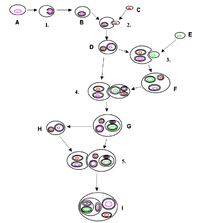
Photo from wikipedia
Lignocellulosic wastes are abundant and considered as the important feedstock. It is a value-added product by using microorganisms. Yet little is known regarding usage of lignocellulosic biomass by anoxygenic photosynthetic… Click to show full abstract
Lignocellulosic wastes are abundant and considered as the important feedstock. It is a value-added product by using microorganisms. Yet little is known regarding usage of lignocellulosic biomass by anoxygenic photosynthetic bacteria although they provide various applications and their biomass are rich in essential nutrients. This limits applications between lignocellulosic wastes and phototrophic bacteria. We examined growth and valuable products of photosynthetic bacterium Rhodopseudomonas faecalis PA2 cultivated in different lignocellulosic waste suspension under light condition. Suspension of rice straw, bagasse, coconut meal, soybean meal, corncob, fiber of palmyra palm peel, and spent coffee ground were prepared by filtration or boiling to be used as sole substrates without additional nutrients. Here we show that the selected strain could grow in the lignocellulosic waste suspension without heat pretreatment. Soybean meal showed the highest biomass, carbohydrate, lipid, carotenoid and bacteriochlorophyll productivities of 0.71 g/L/day, 350, 9.61, 33.11 and 212.54 mg/L/day, respectively, whereas coconut meal was the best substrate for protein productivity (138.61 mg/L/day). Rice straw and fiber of palmyra palm peel seem to be interesting and utilization of fiber of palmyra palm peel in microbial cultivation is reported for the first time. Our results demonstrate that lignocellulosic material suspension can be used as the promising substrates to produce valuable biomass from anoxygenic photosynthetic bacteria without pretreatment and secondary solid waste. We anticipate our investigation to be a starting point for further simultaneous value-added product production by anoxygenic photosynthetic bacteria as well as lignocellulosic waste utilization.
Journal Title: Waste and Biomass Valorization
Year Published: 2021
Link to full text (if available)
Share on Social Media: Sign Up to like & get
recommendations!